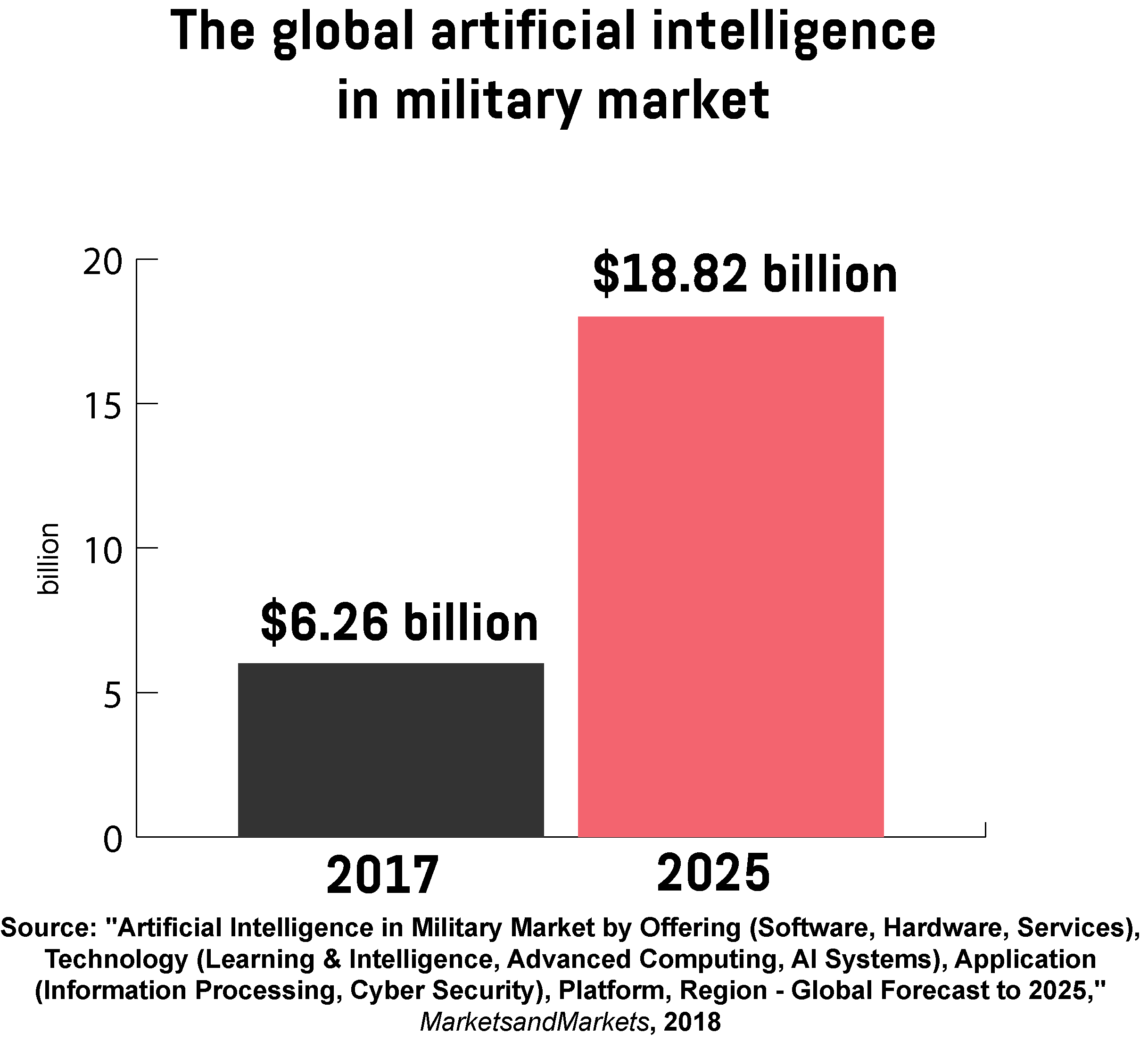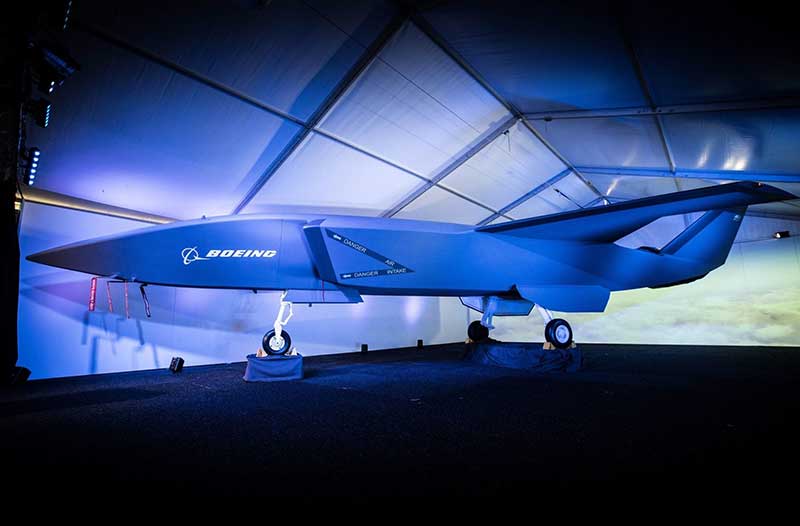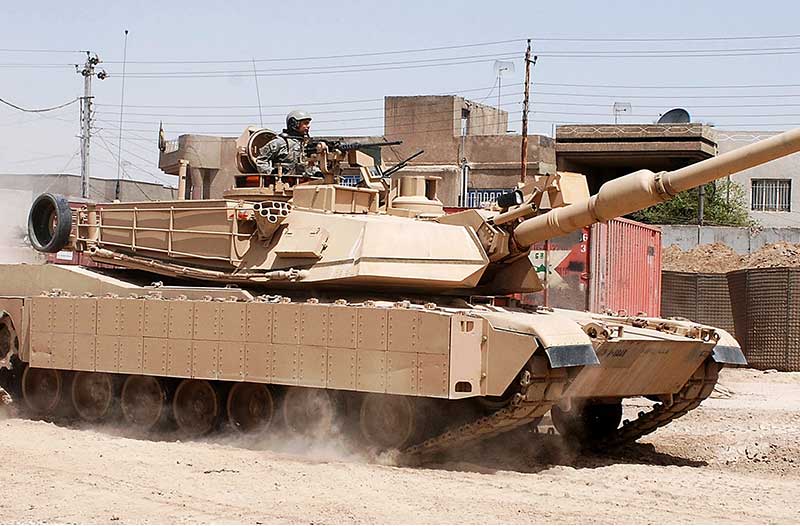- Boeing reveals an autonomous fighter jet
- The US Army plans to develop AI-powered tanks
- Autonomous submarines could soon start roaming our seas
- Should autonomous weapons be banned?
Over the years, artificial intelligence technology has gradually taken hold in almost every aspect of our society. Apparently, it was only a matter of time before military leaders took notice as well and tried to incorporate AI into their arsenal.

As the technology progressed, the concept of autonomous weapons, which used to be nothing more than science fiction, has been steadily moving closer to reality. And we’ve now reached a point where the deployment of autonomous weapons isn’t just possible, but imminent.
In recent years, militaries around the world have significantly increased their investments in autonomous technology, and this trend is set to continue well into the future. According to a recent report published by MarketsandMarkets, the global artificial intelligence in military market is predicted to grow from $6.26 billion in 2017 to $18.82 billion in 2025. The United States accounts for the largest share of the market, while other important players include China, Russia, the United Kingdom, South Korea, and Israel. So what kind of AI-powered weapons can we expect to see, and what exactly will they be capable of?
Boeing reveals an autonomous fighter jet
The US aircraft manufacturer Boeing recently announced plans to develop an autonomous fighter jet called the Boeing Airpower Teaming System. The new aircraft will be 11.6 metres long and have a range of 2,000 nautical miles (3,704 kilometres). Powered by a derivative of a commercially available engine, the aircraft will use standard runways for take-off and landing, with the option to be adapted for carrier operations at sea. However, the company hasn’t revealed what its top speed will be, or whether it will have stealth properties. It will be developed in Australia and is expected to take flight sometime in 2020. The company plans to offer it to customers around the world, who will be able to modify the aircraft according to their needs.
Current aerial combat practices are heavily influenced by human performance factors. There’s a certain limit to how many Gs a human pilot can withstand, how many hours they can fly, and how much information they can process. With unmanned aircraft, there would be no such restrictions. This would create an opportunity for new types of missions that wouldn’t be possible with human pilots on board.


Although it was originally designed to accompany crewed aircraft during combat missions, the Boeing Airpower Teaming System could conceivably be used for many other types of missions, including early warning, intelligence, surveillance, and reconnaissance. “It is operationally very flexible, modular, multi-mission,” says Kristin Robertson, the vice president and general manager of Boeing Autonomous Systems. “It is a very disruptive price point. Fighter-like capability at a fraction of the cost.”
While Boeing claims that the new autonomous aircraft will cost only a fraction of a manned fighter, it still hasn’t revealed just how much that would be, or how much it spent on its development. According to the company, the price will vary depending on the configuration selected by the customer. “We didn’t design this as a point solution but a very flexible solution that we could outfit with payloads, sensors, different mission sets to complement whatever their fleet is,” adds Robertson. “Don’t think of it as a specific product that is tailored to do only one mission.”
The US Army plans to develop AI-powered tanks
Aviation won’t be the only area getting an AI-powered makeover, though. The Army Contracting Command office of the US Army recently invited industry experts and academia to provide assistance in developing technology that would give ground combat vehicles autonomous targeting capabilities. The Advanced Targeting and Lethality Automated System (ATLAS), as this still theoretical concept is named, would enable military vehicles such as tanks to automatically acquire, identify, and engage enemy targets on the battlefield using artificial intelligence and machine learning technologies. Tanks equipped with this system would be able to perform these tasks at least three times faster than those currently in use, which still rely on manual processes. There is, however, one thing they wouldn’t be able to do – pull the trigger. The decision to open fire on a target would still have to be made by a human operator.

According to Paul Scharre, the director of the Technology and National Security Program at the Center for a New American Security, a bipartisan think tank in Washington D.C., ATLAS would give human operators more time to make this decision and improve their accuracy, reducing the possibility of unintended consequences, such as civilian casualties or fratricide. “Anytime you can shave off even fractions of a second, that’s valuable,” says Scharre. “A lot of engagement decisions in warfare are very compressed in time. If you’re in a tank and you see the enemy’s tank, they probably can also see you. And if you’re in range to hit them, they’re probably in range to hit you.”
Autonomous submarines could soon start roaming our seas
Not to lag behind their air- and ground-based colleagues, the US Navy is also looking to add AI-powered vehicles to its ranks. The Navy recently awarded Boeing a $43 million contract to build four Extra-Large Unmanned Underwater Vehicles (XLUUVs) called Orcas. While unmanned underwater vehicles aren’t exactly a fresh idea, earlier versions of the tech have been relatively small and had a very short range. The Orca, however, will be massive. It will be 15.5 metres long and weigh 50 tons. It will feature a modular payload system that will allow it to accommodate different types of payload and support a variety of missions. The internal cargo bay will be 10.4 metres long, with a volume of 56.6 cubic metres and a capacity of eight tons. It will also be able to support external payloads that can be attached to its hull.
It will be powered by a diesel-electric engine, which will give it a range of approximately 6500 nautical miles (12,038 kilometres). It will be able to dive to a depth of around 3,350 metres, while its top speed will be eight knots (14.8 km/h).

Based on Boeing’s Echo Voyager technology demonstration sub and built in cooperation with Huntington Ingalls Industries, the Orca will be able to perform many different kinds of missions, including anti-submarine warfare, anti-surface warfare, electronic warfare, mine countermeasures, and strike missions. For example, it will be able to carry sonar payloads, allowing it to detect enemy submarines and then send their location to friendly helicopters and surface ships. Or, it could carry lightweight and heavyweight torpedoes and use them to attack enemy submarines or surface ships. Furthermore, in addition to detecting mines, it will also have the ability to lay them. It’s equipped with an inertial navigation system and depth sensors, uses satellite communications to report information or receive new orders, and it can surface to determine its exact position via GPS. And since it’s unmanned, the robotic submarine will be able to stay below the surface for months at a time. The Orca will provide the Navy with a much cheaper alternative to conventional submarines. In comparison, the Virginia-class nuclear-powered submarine that’s currently in use costs $2.7 billion per unit. In addition to being cheaper, the Orcas will have another major advantage over conventional submarines – they’ll essentially be disposable, allowing the Navy to use them for missions that would’ve been considered too risky for manned vessels.
Should autonomous weapons be banned?
If the idea of weapons capable of opening fire on their own has you worried, you’re not the only one. The Campaign to Stop Killer Robots, a coalition of non-governmental organisations (NGOs) that aims to ban fully autonomous weapons and retain human control over the use of force, has repeatedly warned that we could be looking at a global robotic arms race that could potentially destabilise the entire world. According to the Campaign, 61 per cent of the population in 26 countries share this view – fully autonomous weapons need to be prohibited.

And the world’s leading robotics and artificial intelligence experts agree. A group of 116 specialists from 26 countries, led by Tesla’s Elon Musk and Alphabet’s Mustafa Suleyman, have signed an open letter urging the UN to ban the development and use of killer robots. “Once developed, lethal autonomous weapons will permit armed conflict to be fought at a scale greater than ever, and at timescales faster than humans can comprehend. These can be weapons of terror, weapons that despots and terrorists use against innocent populations, and weapons hacked to behave in undesirable ways,” reads the letter. “We do not have long to act. Once this Pandora’s box is opened, it will be hard to close.” The group is calling on the UN to add autonomous weapons to the list of weapons banned under the UN’s convention on certain conventional weapons (CCW), which was passed in 1983 and includes chemical and intentionally blinding laser weapons.
That may not be as simple as it sounds, though. So far, 28 countries have supported the ban on autonomous weapons. However, the UN currently employs a decision-making process that allows every member to block any proposed action. And some countries are pushing back strong against this proposition. Coincidentally, it’s the same countries that have the most invested in the technology, including the United States, China, Russia, Israel and South Korea. That means that the UN can’t do anything until there’s consensus and every country agrees that autonomous weapons should be banned. Unfortunately, that’s unlikely to happen.
While US military law currently requires a certain degree of human involvement when making the decision to pull the trigger, it’s not too difficult to imagine this changing sometime in the future. “It looks very much as if we are heading into an arms race where the current ban on full lethal autonomy will be dropped as soon as it’s politically convenient to do so,” says Stuart Russell, a professor of computer science at UC Berkeley and a highly regarded AI expert.
Artificial intelligence technology has the potential to revolutionise warfare. From autonomous fighter jets to AI-powered tanks and submarines, autonomous weapons could soon become an important tool in every military’s arsenal. They could be used to support other units on the battlefield or perform missions that would be too dangerous for manned vehicles. While there’s no doubt that artificial intelligence would make the battlefield safer for human personnel, it’s also possible that it would make the decision to go to war easier, and ultimately result in even greater loss of life.




